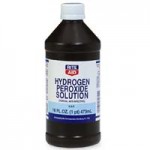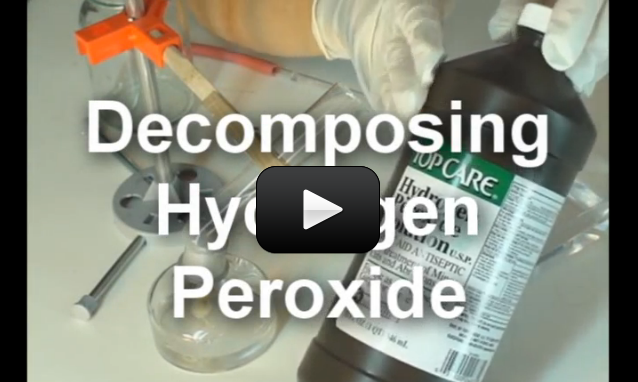 This experiment below is for advanced students. If you’ve ever wondered why hydrogen peroxide comes in dark bottles, it’s because the liquid reacts with sunlight to decompose from H2O2 (hydrogen peroxide) into H2O (water) and O2 (oxygen). If you uncap the bottle and wait long enough, you’ll eventually get a container of water (although this takes a LOOONG time to get all of the H2O2 transformed.)
This experiment below is for advanced students. If you’ve ever wondered why hydrogen peroxide comes in dark bottles, it’s because the liquid reacts with sunlight to decompose from H2O2 (hydrogen peroxide) into H2O (water) and O2 (oxygen). If you uncap the bottle and wait long enough, you’ll eventually get a container of water (although this takes a LOOONG time to get all of the H2O2 transformed.)
Here’s a way to speed up the process and decompose it right before your eyes. For younger kids, you can modify this advanced-level experiment so it doesn’t involve flames. Here’s what you do:
Please login or register to read the rest of this content.


Here’s what’s going on in this experiment:
Hydrogen peroxide (H2O2) breaks down with heat. A decomposition reaction occurs where hydrogen peroxide breaks down into its component elements, H2 and O2
2H2O2 –> 2H2O + O2
2 molecules of hydrogen peroxide are going through chemical decomposition reaction, producing 2 molecules of water and 1 molecule of oxygen.
The charcoal is a catalyst in this reaction and not used up by the overall reaction, but rather it speeds up the reaction so you don’t have ti sit around all day waiting for this to happen. You can also heat the peroxide to speed up the decomposition reaction.
Hope this helps!
Aurora
Hi! We are Decomposing Hydrogen Peroxide, we are using the slow version to decompose the hydrogen peroxide. We are wondering what the purpose of the activated charcoal is? Does it speed up the decomposing? If so, why does it do that? Can we please have the chemical explanation?
Thanks!
When you use hydrogen peroxide to clean a wound, the white bubbly foam is actually a chemical reaction taking place. Hydrogen peroxide (H2O2), is a compound made up of two hydrogen atoms and two oxygen atoms. When it comes into contact with blood, it begins to break apart, making the white foam. Why? Because blood contains an enzyme called catalase (an enzyme is a special protein which speeds up a chemical reaction). The catalase attacks hydrogen peroxide and converts it into water (H2O) and oxygen (O2), and producing bubbles in the process. Hydrogen peroxide kills bacteria, but also healthy cells, so prolonged exposure may turn the tips of your fingers white.
This does not have to do with the experiment, but my family uses Hydrogen Peroxide sometimes to clean cuts and to get the germs out. I was wondering why sometimes when you get Hydrogen Peroxide on your fingers it turns the tips of them white? I was also wondering, when you clean a cut with Hydrogen Peroxide it bubbles?
Thank You.
COOL!!!!!!!!!!!!!!!!!!!!!!!!!!!!!!!!!!!!!!!!!!!!!!!!!!!!!!!!!!!!!!!!!!!!!!!!!!!!!!!!!!!!!!!!!!!!!!!!!!!!!!!!!!!!!!!!!!!!!!!!!!!!!!!!!!!!!!!!!!!!!!!!!!!!!!!!!!!!!!!!!!!!!!!!!!!!!!!!!!!!!!!!!!!!!!!!!!!!!!!!!!!!!!!!!!!!!!!!!!!!!!!!!!!!!!!!!!!!!!!!!!!!!!!!! I DID NOT KNOW THAT!!!!!!!!!!!!!!!!!!!!!!!!!!!!!!!!!!!!!!!!!!!!!!!!!!!!!!!!!!!!!!!!!!!!!!!!!!!!!!!!!!!!!!!!!!!!!!!!!!!!!!!!!!!!!!!!!!!!!!!!!!!!!!!!!!!!!!!!!!!!!!!!!!!!!!!!!!!!!!!!!!!!!!!!!!!!!!!!!!!!!!!!!!!!!!!!!!!!!!!!!!!!!!!!!!!!!!!!!!!!!!!!!!!!!!!!!!!!!!!!!!!!!!!!!!!!!!!!!!!!!!!!!!!!!!!!!!!!!!!!!!!!!!!!!!!!!!!!!!!!!!!!!!!!!!!!!!!!!!!!!!!!!!!!!!!!!!!!!!!!!!!!!!!!!!!!!!!!!!!!!!!!!!!!!!!!!!!!!!!!!!!!!!!!!!!!!!!!!!!!!!!!!!!!!!!!!!!!!!!!!!!!!!!!!!!!!!!!!!!!!!!!!!!!!!!!!!!!!!!!!!!!!!!!!!!!!!!!!!!!!!!!!!!!!!!!!!!!!!!!!!!!!!!!!!!!!!!!!!!!!!!!!!!!!!!!!!!!!!!!!!!!!!!!!!!!!!!!!!!!!!!!!!!!!!!!!!!!!!!!!!!!!!!!!!!!!!!!!!!!!!!!!!!!!!!!!!!!!!!!!!!!!!!!!!!!!!!!!!!!!!!!!!!!!!!!!!!!!!!!!!!!!!!!!!!!!!!!!!!!!!!!!!!!!!!!!!!!!!!!!!!!!!!!!!!!!!!!!!!!!!!!!!!!!!!!!!!